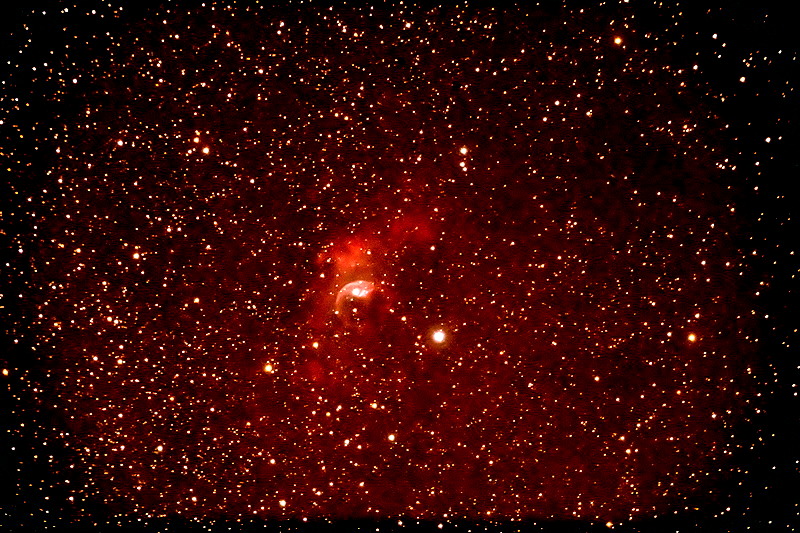Optolong SHO Filters 1st DSO images: Bubble Nebula
Posted: 15 November 2019
Clouds began arriving about sunset on Wednesday, 13 November 2019, and continued until sunset on Thursday, 14 November. A nice Sun Dog was visible over Cassiopeia Observatory as sunset approached.

|
Open: Thursday, 14 November 2019, 1809 MST Temperature: 77°F |
Session: 1407 Conditions: Mostly clear |
Equipment Used:
12" f/8 LX600 w/StarLock
2" 24mm UWA eyepiece
SHO Deep Sky Astronomical Filters
Camera:
D850 DSLR
After opening the observatory I stepped outside and took this handheld photo (f/2.8, 1/2sec, ISO 1600, FL 38mm) of the planets Saturn, Jupiter, and Venus, and the "teapot" of the constellation of Sagittarius.

Mouseover or tap on image for labels
1821 MST: LX600 ON, StarLock OFF, High Precision OFF.
Viewed Saturn and three moons, 102X.
I then began preparing for my first Deep Sky Object (DSO) imaging using the Optolong SII, H-Alpha, and OIII Deep Sky Astronomical filters. The first object would be NGC7635 (Bubble Nebula) in the constellation of Cassiopeia. I attached the Starizona Filter Slider (discussed on my 12 November 2019 report) to the D850 DSLR and mounted the DSLR at prime focus of the 12" telescope.
1826 MST: High Precision ON.
SYNCed the AutoStar II and focused on the star Vega using a Bahtinov Mask with no filter in the Slider. Slewed to NGC7635 (Bubble Nebula).
1846 MST: StarLock ON.
After receiving the filters I did some research on DSO imaging through SII, HA, and OIII filters and learned that different exposures are required for each filter in the ratio of 3:1:2, respectively. I used that ratio for this night's test images. The following images are not processed to show the unedited images. All images are StarLock autoguided, ISO 6400, White Balance 5560K.
no filter, 1 minute

SII filter, 6 minutes

HA filter, 2 minutes

OIII filter, 4 minutes

no filter, 6 minutes

The challenge and work would come later in post-processing. I will say that I found using the Starizona Filter Slider a simple and effective way to change filters without changing the camera orientation.
1917 MST: StarLock OFF.
The eastern sky was brightening from the rising waning gibbous Moon. No more imaging this night.
1934 MST: LX600 OFF.
|
Close: Thursday, 14 November 2019, 1943 MST Temperature: 63°F |
Session Length: 1h 34m Conditions: Clear |
Now that I had images through each of the three filters I needed to edit each individual image (including "stretching" using Levels) and convert each image to a narrowband greyscale image. I began by doing my normal processing in Lightroom and GraphicConverter. In fact, that was all the post-processing that was done with the images taken with no filter. For the SHO filter images I decided to use the "Hubble Pallete" which maps SII to red, HA to green, and OIII to blue. Each image would then be copied and pasted into corresponding RGB channels in Adobe Photoshop to create a full color (yet false color) image. I won't show each step in the process but will show the "final" results. I say "final" because as I learn more about post-processing SHO images I may come back to these images to try to improve them.
Here are the final images of NGC7635 (Bubble Nebula) taken without a filter and edited to bring out the Bubble Nebula and surrounding nebulosity given the exposure.
no filter, 1 minute

no filter, 6 minutes

I then edited each of the images through the filters as described above. During post-processing I noticed that there had been a slight focus change with the filters vs the focus I did without a filter. I'll will have to focus with a filter in the future. This is the resulting image. The color shift is from using the Hubble Pallete.

Well, not bad for a first attempt. The image has more digital noise than I expected; longer or more exposures with each filter should help reduce the noise. But of course, processing this image took a LOT MORE time than was required for the single 6 minutes image with no filter.
The next opportunity for Optolong filter imaging will not occur for awhile due to clouds and rain in the forecasts for the next week.
Comments are welcome using Email. Twitter users can use the button below to tweet this report to their followers. Thanks.
Cassiopeia Observatory Home Page
Copyright ©2019 Michael L. Weasner / mweasner@me.com
URL = http://www.weasner.com/co/Reports/2019/11/15/index.html

